
QUICK SUMMARY:
An effective content brief provides clear instructions for writers, ensuring streamlined content creation for various formats like blog posts and white papers. This essential document enhances efficiency, minimizes redundancy, and sets precise expectations for all involved. Learn the essentials of crafting a compelling content brief to optimize your client's content strategy.
Does your agency rely on creating content briefs to guide writers? Do you often struggle to provide the direction necessary to create quality content based on your client’s specifications?
Rather than continue the uphill battle, agencies who create effective content briefs for their writers get better quality content and waste less time editing articles that fall short. Plus, it means your agency won't have to recreate the wheel each time a new content piece is needed.
In this article, we’ll show you how to create a content brief template that will help your agency streamline its content writing process, making it easier to produce top-notch content for your clients. Read on to learn about:
First, let’s start with a basic definition:
What Is a Content Brief?
A content brief is a document designed to instruct a writer on how to create a piece of content. The finished brief will differ based on the type of content created, such as blog posts, white papers, webinar scripts, product pages, etc. However, regardless of the type, the core concepts behind a content brief remain the same. It creates clear expectations and streamlines the entire content creation process.
Creating an effective content brief is a talent in and of itself. However, the writer may become overwhelmed if you supply too much information. They may also believe they lack creative flexibility, undermining their drive and job quality.
What Does a Content Brief Look Like?
Here's an example of the content brief template we use for our writers:
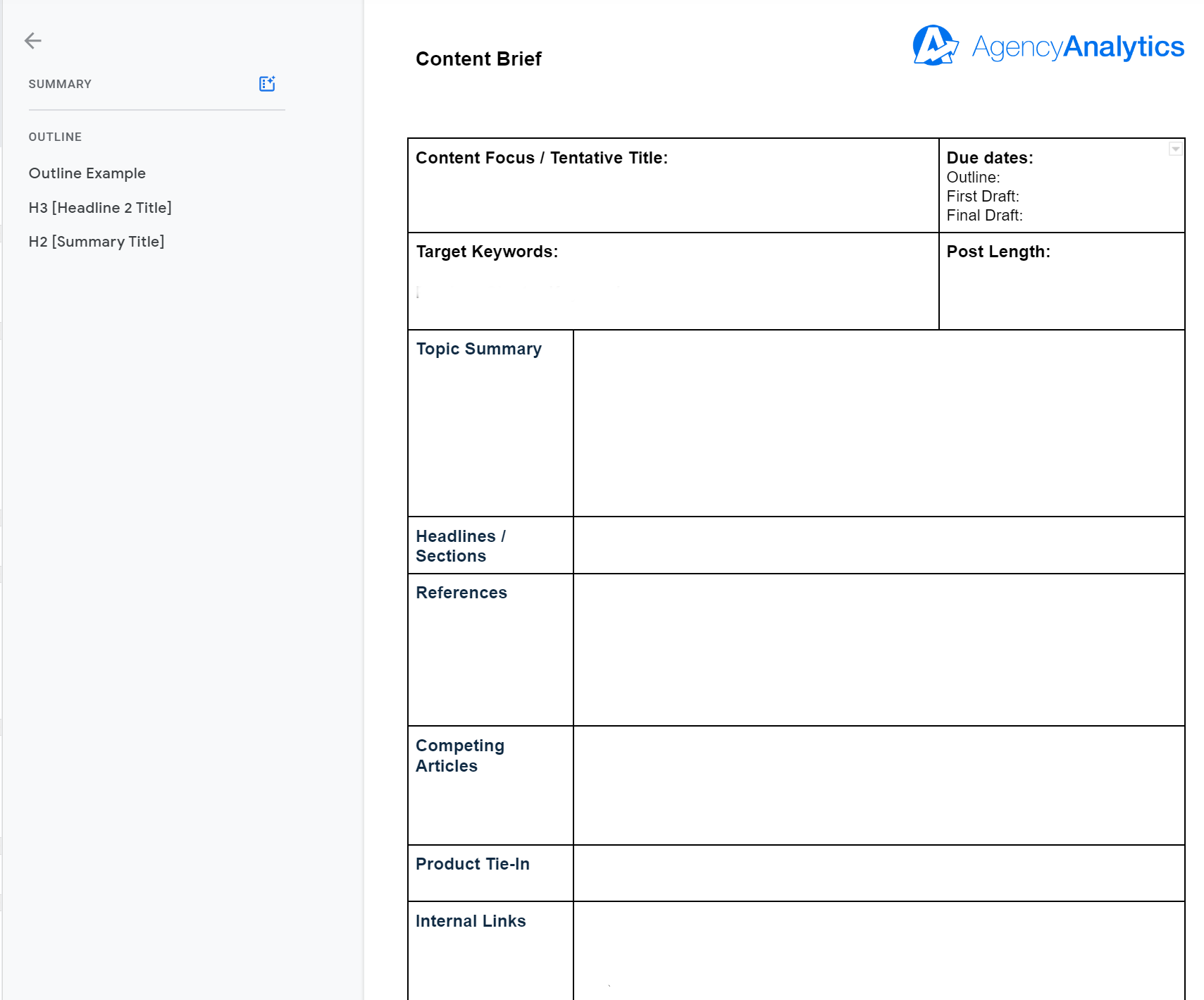
There is no one-size-fits-all when creating content briefs. It's what you want your writers to understand before they delve into the content creation process. While a content brief template is essential (and feel free to use the free content brief template provided above), you can add your customization, such as Project Tone, aligning notes for the intended audience.

Why Are Content Briefs Important?
Writers are not always SEO experts. Experienced writers will have gained some SEO knowledge, but you must specify how you want your article optimized in the brief.
Everyone has their method for developing a content brief template, and there are various steps to creating an excellent brief.
Even with a content brief template in place, things will vary from one project to the next based on details such as:
The type of content (blog post, article, whitepaper, etc.)
Who the content is being created for (in-house or for a client–as well as the intended audience)
The purpose of the content (to inform, have the reader take action, share news, etc.)

Content briefs keep your team completing their content tasks efficiently, helping you move on to the next step-client reporting. Show your clients how the content you're generating is driving their results.

Create professional white-labeled client reports and marketing dashboards with AgencyAnalytics. Start your 14-day free trial.
How Beneficial Are Content Briefs for Your Agency?
If you’re just throwing darts and hoping to win the game of content marketing, you can pretty much do whatever you want. And there are plenty of people accidentally winning at this game. But agencies need to be much more considerate when deciding how to create top-notch content for their clients.
Here are seven reasons why your agency needs a standard content brief:
1. Content Briefs Save Time and Money
While it can take some time to perfect the content brief process, it will be much easier for your writers to know the scope of what they need to write. Whether your writers work hourly, per article, or based on number of words produced, you want to provide as much information so they can focus on writing quality content–while sticking close to your client's goals.
Remember that “cost” is not just about the payment for the article you outsourced, but other hard and soft costs we will outline below.
2. Prevent Rewrites and Reduce Revisions
Rewrites and revisions take time, and the content brief cuts down on the amount of time spent making revisions, changing the concept, or refocusing the target keywords.
Not to mention, you could end up in a situation where the entire content idea gets scrapped after investing a lot of initial time in the writing and editing phase because it does not align with your client’s brand. A well-crafted content brief can often avoid this costly waste of time and effort.
3. Don’t Miss Any Critical Information
Great statistics, facts, and relevant articles can shape an article while making it insightful and authoritative. Thinking strategically during the content brief stage will help ensure the finished blog post doesn’t have any significant information gaps (such as missing the mark on keyword research).
4. Provide a Single Source of Reference for Your Team
Communicating with your client is essential and helps build relationships. You might have an account manager working directly with a client. If they provide updates to your client and discuss what type of content is being produced for the month, the writers need to be kept in the loop.
The content brief process can help explain the scope of the content. This also means you can get more SEO clients that will buy into your SEO content packages with professional procedures and clear wins that they can understand.
Also, your editor or content team can reference the scope while reviewing the drafted article. This will help determine if it's the correct content strategy focus and deliverable promised to the client.
5. Content Briefs Increase Consistency
Standardized processes lead to consistency. Whether tone, facts, messaging guidelines, brand style, buyers' journey, or intended audience. Identifying pain points and setting specific goals can also help the writers align their words with the readers searching for these answers.
6. Improve Search Rankings
Gathering all the questions and concerns for a specific keyword or the type of keyword phrases and subtopics that need to be discussed should be written in the content brief. This will help a search engine identify the core concept of your article, but it will also help your writer create the proper structure and keyword focus to help you rank better.
Of course, search intent is the primary focus. However, understanding the keyword search and identifying who might search for the term can help you write for optimal conversion.
Get the SEO Optimization Checklist 🖥️
Use this template to kickstart your new campaigns!
7. Provide Clear Direction and Faster Approval
Providing clear direction can lead to quick approval of the final drafted article. Your team can feel confident that the content is the best version of well-researched and quality content that might exist. And it matches what was promised to the client in the initial content strategy.
Time originally spent on revisions and rewrites can be spent on enhancing the article with engaging visuals and other assets that bring your client’s content up a notch.
Also, if you are hiring freelance writers, use the content brief to qualify them and set expectations before they start writing. If the writer understands the content brief, it’s a good indicator that the writer can tackle the topic. If not, find someone else to write for you.
8. Delivery Deadlines
Clear objectives, fewer revisions, rewrites, and a faster approval time ensure deadlines are met. In addition, providing your writers with the tools and focusing on writing concise and insightful content reduces the time needed to complete their projects and meet your client's deadlines.
Before we go any further, it’s important to note that no two individuals, companies, or editorial teams will take the same approach when creating content briefs. Focus on what’s best for you and your content writers; everything else will fall into place. However, here are some general guidelines on how to create a content brief that you can use as a starting point.
How To Write an Effective Content Brief in 5 Steps
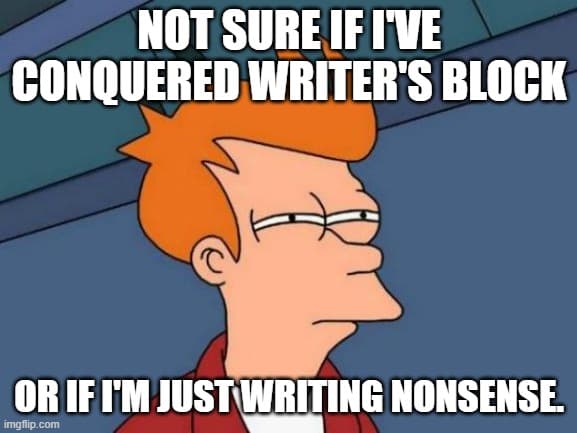
A content brief should include all the information a writer needs to create high-quality content that checks all the boxes.
Remember, a content brief is a document that details the purpose of your content, its target audience, and the desired outcome. It’s a high-level overview of your content marketing strategy.
Keeping things simple and straightforward is essential to creating an effective content brief. Remember that a good content brief aims to help writers create relevant and valuable content that meets your client's objectives.
Too many requirements can overwhelm the writer, while too few can cause confusion. After reading your brief, your writer should understand exactly what you need from them. Writing an effective content brief takes time and practice. We’ve had plenty of failures along the way!
Luckily, we have also learned some great lessons in the process. So let’s look at how you can easily write an effective one.
What Information Belongs In a Content Brief?
Before we provide a detailed look at the most important elements of a content brief, let’s review a full content brief example:
Overview (example)
Title: 5-Step Process to Writing an Effective Content Brief for Writers
Description: A content brief will serve as an essential guide for writers to understand what’s required from them when taking on new assignments. It will also save you time, money, and stress while improving the quality of your final article.
Outline:
Introduction
What Is a Content Brief?
Tip #1:
Tip #2:
Tip #3:
Tip #4:
Tip #5
Conclusion
Here is an example of how we created our content brief for this content brief guide:
What Is a Content Brief?
Why Are Content Briefs Important?
How Beneficial Are Content Briefs for Your Agency?
Content Briefs Save Time And Money
Prevent Rewrites And Reduce Revisions
Don’t Miss Any Critical Information
Provide A Single Source of reference for your content team
Content Briefs Increase Consistency
Improve Search Rankings
Provide Clear Direction And Faster Approval
Ensure Delivery Deadlines
How to Write an Effective Content Brief (5 Steps)
What Information Belongs In A Content Brief?
Should I Use Templates For Content Briefs?
How To Write A Content Brief
Word Count: 3,000+ words
Target Audience: Agency owners and SEO specialists who are in the process of creating a content brief for their clients.
Competition:
What Is a Content Brief? - MarketMuse, 1305 words
What Is A Content Brief (And Why Is It Important)? - Content Harmony 1435 words
How to Create the Perfect Content Brief - SemRush 1950 words
How to Write an SEO-Focused Content Brief Your Writers Will Love - Moz 2951 words
Statistics to Include:
Any relevant stats, facts, or charts that can help visualize
SEO:
Primary keyword: Content brief
Secondary keywords: content brief template, content brief example
Keyword placement: primary keyword once in the intro, body, and conclusion; secondary keywords in subheadings and used naturally throughout
Content structure: introduction, a minimum of five subheadings, and conclusion
Internal links: minimum of five links to internal blog posts
Example:
https://agencyanalytics.com/blog/keyword-search-intent (use anchor text: keyword search intent)
External links: minimum of three links to reputable industry sources and studies
Meta title and meta description
Visuals:
Type: featured image, screenshots, and tables
Number of visuals: include one featured image, three screenshots, and two tables
Placement: featured image before the introduction, screenshots, and tables throughout based on the content
Now that you know what a content brief looks like, it’s time to dig into the five most essential elements to include.
Get the Content Marketing Launch Checklist 📝
Use this template to kickstart your new client campaigns!
1. The Details (Overview)
Think of this section as a high-level overview of the content. Upon reading it, the writer should understand what the piece should entail and the approach they need to take.
These five points should always be part of this section:
Title (or several title ideas)
Two to three-line description of the direction the writer should take
Outline, including headings and subheadings
Word count
Target audience
Create a persona for your audience
Style guide
In the example above, you’ll see that this section kicks things off by providing the knowledge necessary to help the content creator formulate an idea of what’s being asked of them.
Be as clear and concise as possible while understanding that there are other sections where you can share additional information.
Title & Description
While a meta description description and title are important for SEO, it’s also essential to provide more context for your writers. That way, they'll stay focused on the concept of the article and not sway away from the article's intent.
Remember that your proposed title may change during the writing process, but the core concept behind the original title should remain the same.
Outline
Most of the time, you want to target several keyword clusters for your clients. It can be “warning signs of mold remediation” or “difference between mold removal and mold remediation.” As a content marketing agency, you have done all the keyword research and plan of action to target these keywords. Providing an outline eliminates the headache for you and the writers because you’ve clearly outlined the content you want–and don’t want–them to write.
Word Count
Word count is essential for two main reasons:
Cost of the article
Competition
When you write and assign specific content for your client's site, there are many factors. Depending on how you structured your content writing package for your client, you might have to ask your client to pay extra or determine if the cost of the article is within your budget.
The other reason you want to add a word count to the content brief is to stay competitive for the primary keywords you want to rank for.
Let’s say each of the competitors wrote an average of 2000 words, packed with insightful content. If your client’s budget only allows for an article that contains 1200 words or fewer, competing with more authoritative posts on that subject may be challenging. That could mean your content team has to pivot to target a different topic–with lower ranking difficulty or get budget approval to do a more in-depth piece on the subject.

Monitor your clients' content performance with ease. Use AgencyAnalytics to conduct keyword research, identify top-performing content and more–it's free for 14 days.
That’s not to say that this number is everything. A shorter article with real insights is far more valuable to everyone–readers and search engines included–than a longer article full of fluff to just exaggerate the word count.
It could be that a 1200-word count might end up ranking better if the competitive pieces are full of fluffy nonsense. Targeting feature snippets, for example, and providing a concise article might be better. However, when creating the content brief, you need to verify that all sections within the article you want to cover are there. And that - more than anything else - typically informs the required word count.
Target Audience
Persona development is part of any typical content marketing strategy. When a sales agent knows who they're selling to, they may adapt their sales pitch to fit that customer's demands and enhance their conversion rate.
The same goes for a writer. One who understands who they're writing for can better customize the message of the piece and their language to that specific audience.
Construct an audience persona to help your writer understand who they're writing for. This is a text, graphical representation, and profile of a 'person' who represents your target audience.
An audience persona might be as simple as a few sentences identifying your target demographic, frequent pain issues, education level, and anything else you know is vital to your audience.
Here’s an example of what you would include in the target audience section of your content brief:
The primary target audience for the client may be females from 35 - 49, but perhaps this article is intended to reach a specific subset of the audience. For example, maybe this piece is needed to support the client’s new line of green cleaning products. Therefore, the persona could be adjusted to focus on those in the higher range of that demographic (e.g., 42 - 49), married with kids and interested in the environment.
Style Guide
Each client is different. Whether your client needs to target B2B, B2C, SMBs, medium-sized business owners, homeowners, etc., your tone and style of writing and spelling conventions (e.g., UK vs. US English) should cater to these audiences at a granular level.
Report Smarter, Not Harder.
Better, Faster & Easier Client Reports Are Just a Few Clicks Away
Start Your Free Trial Today2. Competition
In a perfect world, there would be no competition for the assigned topic. But in the real world, you know this is never (or very rarely) the case.
You'll still have competition even if you’re tackling a relatively unknown angle in a less popular niche. After all, there are more than 2.98 billion indexed pages on the internet.
So, that’s why it's important to provide a competition section in your content brief. Here’s what you should include:
Run a search for the primary keywords you’re targeting, or use a rank tracker tool to run it for you
Make a note of the top 10 to 20 search results
Find similar content already published on the top competing websites
For this example, let’s look at what Google returns for the keyword string “how to write a content brief.”

We can see there are approximately two billion results in this keyword research. Of course, there are other factors at play in ranking for this term, but that alone tells you it's pretty competitive.
A review of the first page provides a clear idea of top competitors, their approach, and the type of content they’ve shared on the subject.
You should review three to five of these top pages to help guide the details you share with your writer.
For example, if you find that the top result's average word count is 1,500 words, you can set the content brief requirement for 2,000 or more words to ensure your finished content is more in-depth than the competition.
Do the top-ranking articles have engaging and relevant graphics to support them? If so, you should plan on creating those as well. (We’ll cover more on visuals in a moment.)
You can use this information to guide the creation of your content brief, which is then shared with the writer, so they understand what it will take for their content to perform alongside the top players.
3. Research
Even if you expect the writer to perform a lot of keyword research independently, it doesn’t mean you shouldn’t help. On the contrary, by providing keyword research on the topic, it’s easier for you to guide how the writer creates the content, which improves the likelihood of it aligning with your requirements. It also results in a more refined content marketing strategy.
This section can include, but is not limited to:
Competitor links
Resources to find content ideas
Recent studies
Recent statistics
Related blog posts
This is especially true if your content was inspired by a recent industry trend, research report, or external analysis. Make sure to provide the writer with what inspired the idea in the first place.
You can’t (and don’t want to) include every piece of research in your brief, but it never hurts to give the writer a jump start. This is also where you can call out your agency’s citation guidelines. For example, if you don’t reference or quote published sources older than two years, this would be the place to note that.
4. SEO
When writing a blog post or other content, the SEO section of a content brief is critical, as you want to give it the best chance of ranking at the top of the search engines.
Download Your 39-Point SEO Content Checklist
Everything you need to make sure your agency is publishing optimized content.
Of course, the importance of the search engine optimization section depends largely on your content marketing plans. But if it makes sense, you’ll want to share as much information with the writer as possible, such as:
Topic focus
Keyword research (i.e., primary and secondary keywords)
Content structure, including the use of subheadings
External and internal links
While most of these details will vary from one brief to the next, some standardization guidelines will remain.
For instance, you may have strict rules about the the number of internal links to include and how often primary and secondary keywords appear.
An example of this is Ahrefs for keyword research (and more). For example, a search for content brief returns the following results:
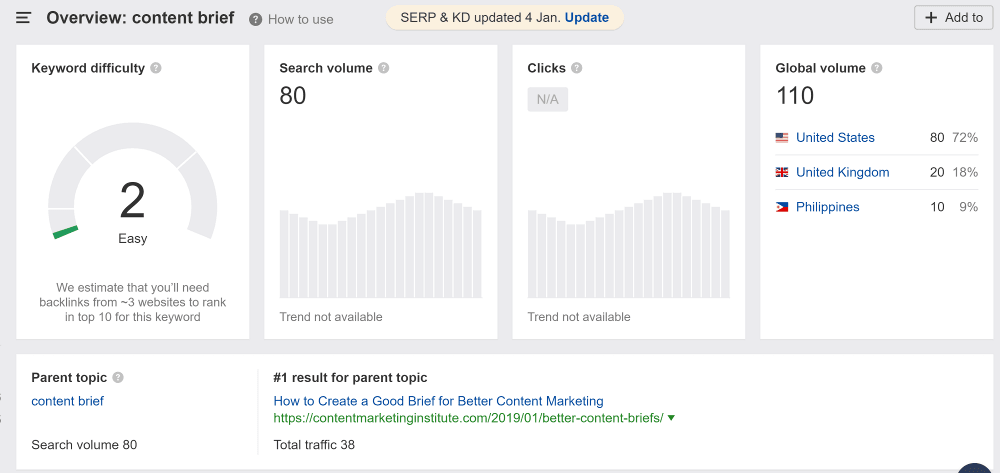
Upon conducting a thorough review of the keyword, you’re able to answer questions such as:
Is the keyword worth pursuing from a volume perspective?
Are there other keywords that are better to target?
Are there alternate versions or different keywords to target in the same piece of content?
How difficult will it be to reach the top of the search results?
Identify Keywords and Search Intent
Start with keywords-after all, everybody who knows anything about SEO understands the significance of keywords.
Knowing what keywords you are targeting for search engine rankings and the objective behind the content is the beginning point for each article.
If the keyword search intent is transactional, the post should be focused more on features and benefit messaging. In addition, the content should provide valuable insights and information with minimal product placement if the keyword intent is information.
Identifying both the keywords and the search intent must be expressed clearly to a writer from the start if you want to end with an article that covers the topic in the way your agency intended.
For example, you don’t want an informational article about dealing with yellow bathtub stains to become an article that says “buy this product and here’s why” as it does not support the informational intent behind the keyword.
Once you've decided on your keywords, which will also inform the headline of your post, you'll need to offer some context for the piece's goal. This is vital for SEO and creating a nice reading experience.
Specify in your brief that you want a step-by-step tutorial, bullet points, or other high-value content structures.
While providing the primary keyword offers a writer a basic notion about the post, it still leaves most of the content, aim, and direction open to interruption.
Add Topics and Subtopics to Be Covered
As part of your brief, offer some subtopics or subheadings you wish to see in the blog post.
Subheadings do more than only offer structure to an article; they also:
Aids readers scanning your blog post in finding what they're seeking for
It gives Google a clearer understanding of your content
Breaks up the “wall of text” to make the blog post easier to read.
Allows you to rank for additional keywords within those subheadings.
Provides search engines with snippets to show in featured positions
If you're unsure what subtopics to add, go to Google and check what's suggested for your term on the search results page (SERPs).
Internal or External Links You Should Add
Including a mix of links is critical for both the long-term impact of SEO and the credibility of the article.
Adding links comprises two steps.
The first is to inform your writer that any metrics, facts, or statistics they've referenced in the work should be linked.
The second step is to submit a list of internal and external links that you would want to see in the article.
While some links will happen naturally during the writing process, providing a baseline set of links is very beneficial to the writer. They can read the articles you've asked them to link to and gain a deeper and more in-depth grasp of the subject.
Internal linking of the existing articles that cover similar topics is a great way to provide more context for users and search engines.
Plus, you can provide guidelines on the quantity and quality of links to be excluded. For example, you can clearly outline that there should be:
No more than 3 links from outside sources
All links should be to high-quality, relevant websites
Do not use external links that are focused on a similar topic
At least 3 but no more than 6 internal links
5. Visuals
Who wants to read a giant block of text?
The answer is simple: no one!
Plus, compelling visuals are a great way to generate quality backlinks.
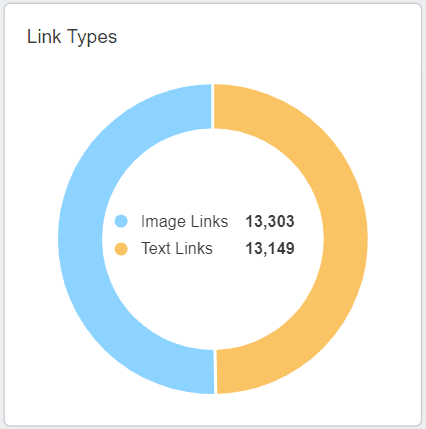
That’s why every content brief should include a section for visuals.
It's important to note that this is only necessary if the writer is also expected to provide visuals. If you plan on doing this in-house after reviewing the content, you may not need to include it in the brief - but it certainly doesn’t hurt.
Even if they are not providing finished visuals, it is handy to have them paste links to some source graphics that can be referenced in the article or recreated by your internal team.
Some of the points to include:
The visuals you want to include in the article (photos, infographics, charts, screenshots, etc.)
The number of visuals
The preferred placement of visuals
Naming conversion for the visuals
Maybe you want the writer to recommend a featured image and three to five others to include in a blog post. You can share this direction, along with a list of sites for finding images (if your client uses stock photography):
Since choosing the right images is often subjective, sharing as many details as possible is best. For example, you could ask the writer to do one of the following:
Share five images related to social media.
Share five images related to social media, with three of the logos of specific platforms and the other two screenshots from popular profiles.
Which one sounds better to you? (Hint, it’s #2)
Receive Agency Growth Tips, Delivered to Your Inbox
Ask for Feedback
Even if you’re impressed by the depth and clarity of your content briefs, it doesn’t necessarily mean your writers agree. And that’s why you need to ask for feedback. Ask questions such as:
Are your content briefs clear and complete?
Do they help you understand what is being asked of you?
What is your favorite part of the briefs?
What is one (or two) thing you would change in future briefs?
Maybe you’ll find that your content briefs are hitting home with every writer. Or maybe you'll find a few holes that you can patch up to share better and more detailed content briefs in the future. You never know until you ask.
Final Thoughts
Assuming a writer doesn’t need a content brief is a mistake. Even the best ones need a brief to hit all SEO goals and align with your clients’ needs.
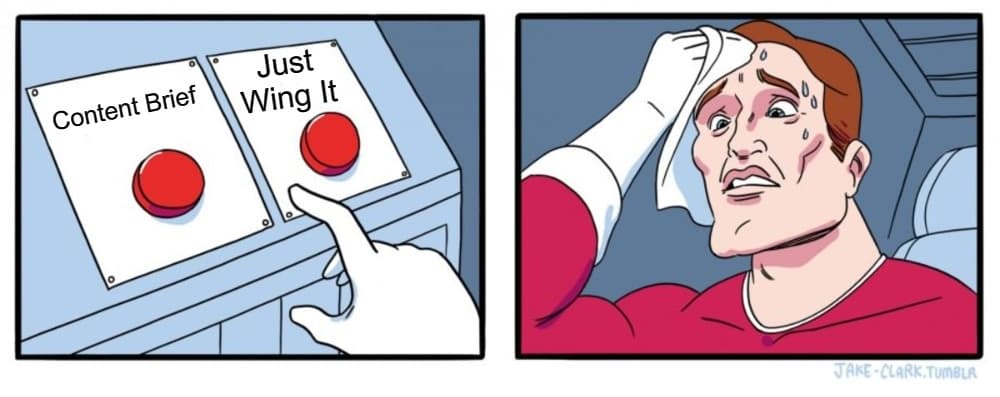
Although it will take some time and practice, the guidance above puts you and your agency in a better position to create detailed content briefs for writers.
With a keyword rank tracker and a full suite of SEO tools, bring all your clients' metrics under one roof. Create client-ready reports in minutes with AgencyAnalytics. Try it free for 14 days.

Written by
Jay Kang is an SEO Expert with over 9 years of experience crafting powerful content strategies, driving keyword optimization programs, and delivering significant organic growth.
Read more posts by Jay Kang ›Get Started for Free




